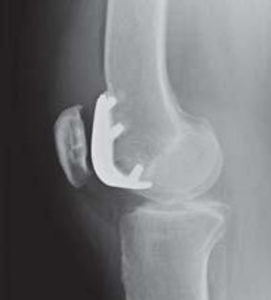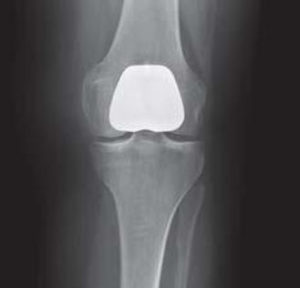A patellofemoral replacement is a surgical procedure used to treat patients with bone on bone osteoarthritis of the patellofemoral joint. This is the joint surface between the “knee cap” (patella) and the end of the “thigh bone” (femur).
INDICATIONS
Patellofemoral replacements are an artificial resurfacing of the patellofemoral joint used to treat patients with isolated bone on bone osteoarthritis of the patellofemoral compartment. Patients with patellofemoral arthritis often present with symptoms of anterior knee pain that is worse with climbing stairs and sitting for prolonged periods of time. Patients will also likely experience a crunching or grinding sensation when doing stairs or standing from a seated position. Patellofemoral replacements are most commonly performed in women in their early to mid-40s through mid-50s. We do, however, perform this procedure in other patient populations based on medical necessity. To determine whether or not you are a candidate for a patellofemoral replacement your surgeon will first obtain plain x-rays to assess areas of bone on bone osteoarthritis. Your surgeon may then have you get an MRI to ensure that the other areas of your knee are normal. If there are any irregularities in the other compartments of your knee you may have to discuss alternate treatment options with your surgeon.

WHAT WILL HAPPEN DURING MY SURGERY?
Your surgery will be performed using either a general anesthetic or a spinal anesthetic depending on your preference. During your surgery your surgeon will make an open incision along the front of your knee running up and down your leg. Through this incision the damaged area of your joint will be treated. The femoral side of your knee will be resurfaced with a metal plate made from cobalt chrome. The back side of your patella will be resurfaced with a “button” made of polyethylene plastic. Both of these components are held in place using methylmethacrylate cement, (bullet proof glass). Once the cement is hardened and your implant is well fixed your surgical incision will be closed. This will be done using all “dissolving” stitches. This means that you will not have any stitches that need to come out.



WHAT CAN I EXPECT POST-OPERATIVELY AFTER A PATELLOREMORAL REPLACEMENT?
When you awake from surgery you will have a brace on your leg that will keep your leg straight. It will be important for you to wear this brace at all times when you are up and about until your quadriceps muscles allow a good straight leg raise (SLR). You do not have to wear your brace to sleep. You will also be given crutches. You will be able to fully weight bear on your operative leg immediately following surgery however, it is a good idea to use your crutches for support as your muscles will be weak following surgery. You will use your crutches anywhere from 1-3 weeks depending on your muscle strength. You will spend from 1-2 nights in the hospital based on your comfort, mobility and pain control. Do plan on spending one night. This time in the hospital also allows you to also meet with physical therapy and get some early exercise and crutch training. You will begin working with a physical therapist in the first few days following surgery. You can elect to have a visiting physical therapist come to your home for the first 1-2 weeks, but it is best if you may make arrangements at an outpatient physical therapy office as they have more methods and equipment to speed up your recovery, maximizing your range of motion (ROM), strength and mobility weaning off crutches quickly, 2-4 weeks. After surgery you will use a baby aspirin twice daily for 3 weeks to prevent blood clots, (81mg 2x/day x 3 weeks).This is done as a preventative measure for all of our patients to help prevent blood clots following surgical intervention.
